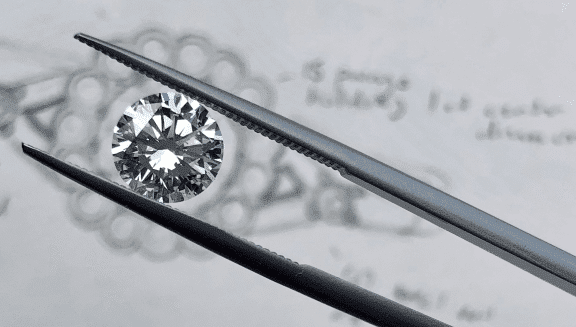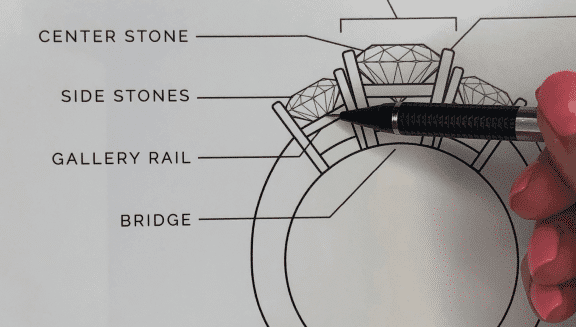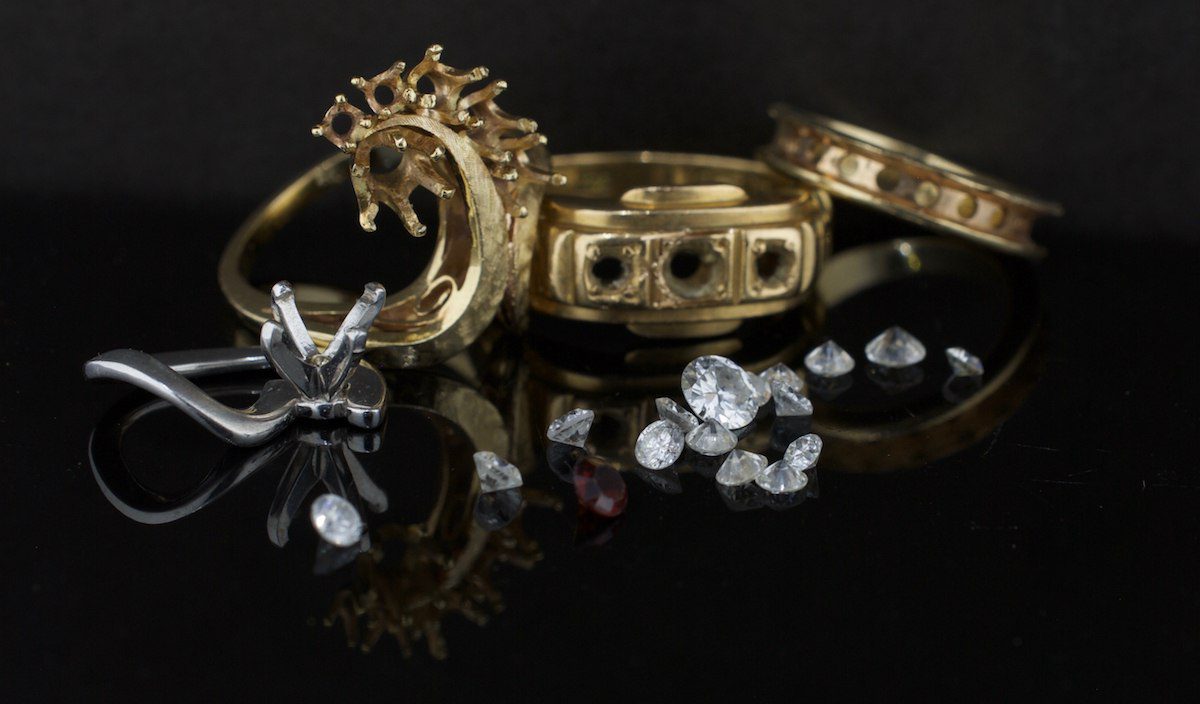Trendy Engagement Rings You Need to Avoid
Have you seen those magical, iridescent moonstone rings all over social media? Or maybe you’re being targeted with those cool southwestern looking rings with made from silver and turquoise. What about the edgy, geometric shaped grey diamond rings?
Let’s face it, if you’re browsing engagement rings (or advertisers believe you’re in the demo that might be) you’re being targeted with lots of different ring ads, and with good reason: for the first time in history brides are finding their engagement rings through Instagram and Pinterest instead of big box jewelers and retailers. This shift has caused more than a few waves, specifically, we have more options than ever before and millenials are moving away from diamonds rings and toward unconventional center stones . Unfortunately, there’s a lot more to what makes a good engagement ring than what stones looks pretty on a mobile phone or what ring gets the most likes. Some of the most exotic looking gemstones and prettiest settings aren’t actually suitable for engagement rings because they’re not strong enough to be worn everyday. Sadly, these rings don’t come with a disclaimer.
There’s a reason why these quirky materials have taken a backseat to traditional choices for so many centuries, and it’s not as simple as a diabolically clever marketing campaign
If you’re considering any of these materials for a fashion ring to wear on special occasions or if you don’t mind replacing your ring within a few months or years, go for it! Seriously. Most of the materials that aren’t durable enough to wear everyday are stunning, that’s why they’re so popular. But before you put that trendy ring in your cart, you should know what you’re signing up for. In this article, we’ll go over what engagement ring to avoid and the science behind what makes a good engagement ring.
WATCH: Abby Sparks Jewelry CEO & Founder on Trendy Engagement Rings
What Makes Stones Bad For Engagement Rings?
In a word: science.
Developed in 1812 by German geologist Friedrich Mohs, the Mohs Hardness scale (pronounced “moze”) is used to identify a gem or minerals hardness and resistance to being scratched. This scale has been used by jewelers and geologists for centuries and is still the undisputed authority today.
The scale works like this: a mineral gets a higher rating than a mineral that it can scratch. Diamonds are unable to be scratched by any other mineral or gem and therefore get a perfect 10 rating. The second hardest mineral can be scratched only by diamond but, here’s the thing — this scale isn’t linear, it’s logarithmic — meaning that a diamond isn’t just 1x as hard as the next hardest mineral, it’s many, many times harder (as shown with the sharp upswing in the graph below).

This scale and the concept of stones being harder than others can be a real wake-up call for most people. It also sheds light on why so many engagement rings use diamonds: they’re simply the hardest natural substance on earth and engagement rings tend to go through a lot of potentially damaging situations within a lifetime of wear.
Jewelers use the Mohs Scale because it determines which gems are suitable for jewelry making. The harder a stone is, the easier to work with and set without breaking and the more able to handle the wear and tear of everyday tasks without being scratched. If you’re a jeweler who makes fashion or special occasion jewelry, you can work with a wide range of gems. If you’re looking to make a ring that’s going to last forever, your choices are few. Herein lies the problem for consumers: you don’t necessarily know the difference between the two, and it’s not something that’s clearly labeled when you’re ring shopping.
Even so, some people still choose a soft gemstone engagement ring, weighing that the beauty of the stone outweighs the risk of breaking it, and maybe they can take extra care. Unfortunately, the reality is that everything from putting your hand in your pocket to accidentally tapping it against your car door has the potential to leave a lasting scratch. Even at our most careful, our normal everyday actions put a soft stone at risk, and after you get the ring, you’ll want to wear it 24/7, show it to as many people as possible, and stare at it all the time. Do this with a vulnerable stone and it probably won’t last very long — leaving you with a ruined engagement ring, or worse none at all.

Photo courtesy of Estate Diamond Jewelry.
Engagement Ring Stones to Avoid
We won’t work with any stones lower than a 7 in the studio, period, and we don’t recommend them for anyone. Here’s a list of the stones and materials that includes:
- Moonstone
- Turquoise
- Pearl
- Labradorite
- Lapis Lazuli
- Rose Quartz
To a lesser extent, we are really cautious about stones that hover around a 7 like opal, emerald or amethyst and are transparent that it’s going to require extreme caution and care, and that still might not be enough to protect the stone. Bottom line is, we won’t consider a 6 or lower and you shouldn’t either unless you’re prepared to have it break. Remember that the Mohs scale is logarithmic, so a moonstone isn’t just a little bit less durable than a stone with a 7 rating, it’s many times less durable.
Beyond gem hardness, jewelers also rate diamonds and gemstones on toughness, resistance to breaking or chipping, and resistance to temperature changes and household chemicals. Diamonds and sapphires rate high on this scale, but opal, moonstone, and pearl rate very low in these categories.
Beyond chipping and breaking, certain soft stones have distinct weaknesses:
- Opals can crack or craze if they get too dry, ending up looking like shattered tempered glass.
- Pearls can lose their trademark iridescence if exposed to hot water, leaving them looking like yellowed plastic.
- Pearls are very porous and susceptible to chemicals which they absorb.
- Over time, Pearls can naturally erode and deteriorate away.
With obsessive levels of proper care and restraint, these stones can be preserved, but it’s important to know how much effort is needed to care for your stones and if proper care is something you can invest your time into before purchasing softer stones. There are people out there that are lucky enough to inherit heirloom pearl jewelry or have an opal ring that’s lasted an entire lifetime, but this is rare.

(The Amanda opal engagement ring, before wear).

(The Amanda opal engagement ring after long-time wear).
The Worst Engagement Ring Styles and Settings
Once you’ve chosen strong stones for your ring, you need to look critically at the overall style and setting. One of the biggest trends in the last few years is dainty, delicate, wispy looking jewelry with barely there metal. The problem is that metal is what secures your stones in place and a lack of it is guaranteed to lead to problems. When you’re looking at rings, think about what looks like it could actually withstand being worn every day. Here are some of the design details that don’t make the cut:
- Super dainty thin bands
- Micro pave, or teeny tiny diamonds
- Delicate prongs that don’t securely hold the stone(s) in place
Engagement Ring Metals and Band Materials To Avoid
No matter your center stone and engagement ring setting, if it’s set in the wrong metal or material it won’t last. Organic materials like wood and animal bone naturally deteriorate over time, and some rings made with these materials simply break shortly after you put it on. Then there are metals that seem hard at first, but are actually much softer than fine jewelry grade metals like gold and platinum. These soft metals dent or warp under pressure, making a normally round ring look and fit like an oval, and beyond being unsightly and feeling uncomfortable, stones are prone to falling out. Here are the band materials we strongly advise against:
- Sterling silver
- >Plastic
- Dinosaur bone
- Antler
- Wood
- Steel
- Tungsten
Better Choices for a Trendy Look
Non-traditional stone choices make for a really unique-looking ring, and if that’s what you have your heart set on, it can be hard to find a ring that feels special enough amongst a sea of colorless stones and homogenous designs. Luckily, there are some really beautiful unconventional materials that are tough enough to last a lifetime. Diamonds, for one, are available in a wide range of colors and clarity. Pink, yellow, blue, black, champagne, and chocolate are some of the most well-known options. Rough diamonds (also called raw diamonds, rustic diamonds, and rose-cut diamonds) have varying degrees of opacity and color and are VERY popular right now. The most commonly used rough diamonds are cloudy grays and blacks. Rose-cut diamonds denote a specific cut and are commonly found in milky opalescent colors.
If you know that you absolutely don’t want a diamond, sapphire and rubies are your next best bet. Both stones have been used in jewelry for centuries, and continue to be for a good reason: they last and come second only to diamonds in terms of durability. And though blue is the most well-known color for sapphires, they actually come in all colors of the rainbow and different levels of clarity. You can find the color-change of a moonstone or pearl, the greenish/blue hue of turquoise, as well as pinks and yellows.
Bottom line: before you fall in love with an unconventional material or non-traditional stone choice, ask yourself why you haven’t seen anyone else with this type of ring. Better yet, look up its rating on the Mohs scale. There are plenty of colorful and alternative materials that are also durable, check out our custom engagement ring portfolio to get inspired. And one surefire way to get a unique ring minus the risk of it breaking: go unconventional with the design, not the materials.
Want to be even more informed on all your engagement ring choices? Download our free guide: 7 Things You Need to Know Before Buying an Engagement Ring.






Comments